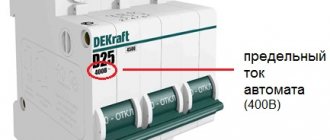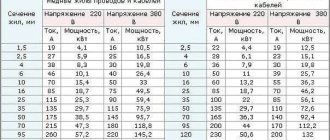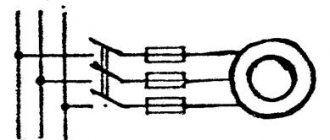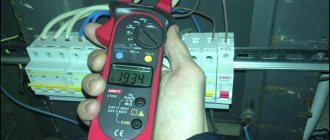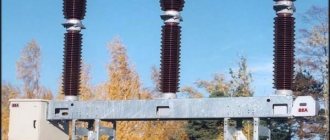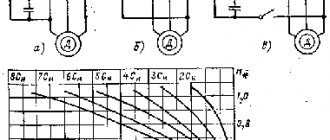The choice of protective circuit breakers is made not only during the installation of a new electrical network, but also when upgrading the electrical panel, as well as when additional powerful devices are included in the circuit, increasing the load to a level that old emergency shutdown devices cannot cope with. And in this article we will talk about how to correctly select a machine based on power, what should be taken into account during this process and what are its features.
Failure to understand the importance of this task can lead to very serious problems. After all, users often do not bother themselves when choosing a circuit breaker based on power, and take the first device they come across in the store, using one of two principles - “cheaper” or “more powerful”. This approach, associated with the inability or unwillingness to calculate the total power of devices connected to the electrical network and select a circuit breaker in accordance with it, often becomes the reason for the failure of expensive equipment due to a short circuit or even a fire.
What are circuit breakers for and how do they work?
Modern AVs have two degrees of protection: thermal and electromagnetic. This allows you to protect the line from damage as a result of prolonged excess of the flowing current of the rated value, as well as a short circuit.
The main element of the thermal release is a plate made of two metals, which is called bimetallic. If it is exposed to a current of increased power for a sufficiently long time, it becomes flexible and, acting on the disconnecting element, causes the circuit breaker to operate.
The presence of an electromagnetic release determines the breaking capacity of the circuit breaker when the circuit is exposed to short-circuit overcurrents, which it cannot withstand.
An electromagnetic type release is a solenoid with a core, which, when a high power current passes through it, instantly moves towards the disconnecting element, turning off the protective device and de-energizing the network.
This makes it possible to protect the wire and devices from an electron flow, the value of which is much higher than that calculated for a cable of a particular cross-section.
What is the danger of a cable mismatch with the network load?
Selecting the correct power circuit breaker is a very important task. An incorrectly selected device will not protect the line from a sudden increase in current.
But it is equally important to choose the correct cross-section of the electrical cable. Otherwise, if the total power exceeds the rated value that the conductor can withstand, this will lead to a significant increase in the temperature of the latter. As a result, the insulating layer will begin to melt, which can lead to a fire.
To more clearly imagine the consequences of a mismatch between the wiring cross-section and the total power of the devices connected to the network, let’s consider this example.
New owners, having bought an apartment in an old house, install several modern household appliances in it, giving a total load on the circuit equal to 5 kW. The current equivalent in this case will be about 23 A. In accordance with this, a 25 A circuit breaker is included in the circuit. It would seem that the choice of the circuit breaker in terms of power was made correctly, and the network is ready for operation. But some time after turning on the appliances, smoke appears in the house with a characteristic smell of burnt insulation, and after a while a flame appears. The circuit breaker will not disconnect the network from the power supply - after all, the current rating does not exceed the permissible one.
Selecting a machine by rated current
The considered formulas are widely used in calculations of the input circuit breaker. Using one of them - I = P/209 with a load P of 1 kW, the current strength for a single-phase network is 1000 W/209 = 4.78 A. The result can be rounded up to 5 A, since the actual voltage in the network is not always corresponds to 220 V.
Thus, the current strength was 5 A per 1 kW load. That is, a device with a power of more than 1 kW cannot be connected, for example, to an extension cord marked 5 A, since it is not designed for higher currents.
Circuit breakers have their own current rating. Based on this, it is easy to determine the load that they can withstand. There is a table to simplify the calculations. A machine rated 6 A corresponds to a power of 1.2 kW, 8 A – 1.6 kW, 10 A – 2 kW, 16 A – 3.2 kW, 20 A – 4 kW, 25 A – 5 kW, 32 A – 6, 4 kW, 40 A – 8 kW, 50 A – 10 kW, 63 A – 12.6 kW, 80 A – 16 kW, 100 A – 20 kW. Based on the same ratings, calculations are made for the machine's power at 380V.
Weak link protection
So, we are convinced that the calculation of the circuit breaker should be made based not only on the total power of the devices included in the circuit (regardless of their number), but also on the cross-section of the wires. If this indicator is not the same along the electrical line, then we select the section with the smallest cross-section and calculate the machine based on this value.
The PUE requirements state that the selected circuit breaker must provide protection for the weakest section of the electrical circuit, or have a current rating that will correspond to a similar parameter for the installations connected to the network. This also means that the connection must be made using wires with a cross-section that can withstand the total power of the connected devices.
How to select the wire cross-section and rating of the circuit breaker - in the following video:
If a careless owner ignores this rule, then in the event of an emergency that arises due to insufficient protection of the weakest section of the wiring, he should not blame the selected device and scold the manufacturer - only he himself will be to blame for the current situation.
Features of the operation of single-pole and double-pole AV
The essence of the work of each of these types, in general, can be understood from the name. A single-pole circuit breaker is designed to disconnect one line. A two-terminal network differs from it in that it controls the working process in two lines simultaneously and compares the parameters of the electron flow, determining whether it corresponds to the value that is permissible for the correct operation of the network. If these indicators are exceeded, the device is triggered, turning off the power to both lines simultaneously.
Some readers may have a question: is it possible to replace a two-pole circuit breaker with a pair of single-pole switches? This should not be done under any circumstances. Indeed, in a device with two poles, its elements are connected not only by a common lever, but also by a locking mechanism.
This means that if a problem occurs, they will turn off simultaneously, and in a pair of single-pole circuit breakers independent of each other, only one circuit breaker will work. In this case, electric current will still be supplied to the faulty circuit through the switched on device, which may cause a fire in the wiring. You can see the attempts at unification in the following video:
The difference between these two types of safety switch lies in the design of the release. A two-pole circuit breaker must have a tripping element, the configuration of which allows both parts of the device to be turned off simultaneously, both during automatic operation and during manual operation.
If the electrical circuit in the apartment is single-circuit, then there is no need to install a two-pole circuit breaker in it, since there is no need to simultaneously protect different segments of the room. But in the case when complex equipment is installed in one of the rooms, which, due to its parameters, cannot be included in one common circuit, you cannot do without a multi-terminal network.
For clarity, consider this example. Let's say there are two lines in the home network, one of which is connected to a complex device, and it is supplied with power through a rectifier.
If there is a violation in one of the lines, then as a result of its disconnection, the supply of power to one circuit will cause a voltage surge, and therefore an increase in other parameters. If the AV of the second line does not operate in a timely manner, the result will be failure of the device, and possibly a cable fire. That is why such a network must be protected by a 2-pole device.
What will happen in the opposite situation, when they try to disconnect a multi-pole circuit breaker, in the video:
How to calculate the rating of a circuit breaker?
Let's assume that we took into account all of the above and selected a new cable that meets modern requirements and has the required cross-section. Now the electrical wiring is guaranteed to withstand the load from switched on household appliances, even if there are quite a lot of them. Now we proceed directly to the selection of a circuit breaker based on current rating. Let's remember the school physics course and determine the calculated load current by substituting the corresponding values into the formula: I=P/U.
Here I is the value of the rated current, P is the total power of the installations included in the circuit (taking into account all consumers of electricity, including light bulbs), and U is the network voltage.
To simplify the selection of a circuit breaker and save you from the need to use a calculator, we present a table that shows the ratings of the circuit breakers that are included in single-phase and three-phase networks and the corresponding total load power.
This table will make it easy to determine how many kilowatts of load correspond to which rated current of the protective device. As we can see, a 25 Ampere circuit breaker in a network with a single-phase connection and a voltage of 220 V corresponds to a power of 5.5 kW, for a 32 Ampere circuit breaker in a similar network - 7.0 kW (this value is highlighted in red in the table). At the same time, for an electrical network with a three-phase delta connection and a rated voltage of 380 V, a 10 Amp circuit breaker corresponds to a total load power of 11.4 kW.
Visually about the selection of circuit breakers in the video:
How many kilowatts can a machine withstand 16, 25, 32 and 40 Amps?
Previously, the website elektriksam.ru published an article about cable load calculations. You can read the article here: https://elektriksam.ru/raschet-nagruzki-na-kabel.html
So, you have chosen, for example, a cable, and you need to select a machine for it, or vice versa, it is not so important. The main thing is to know how many kilowatts this cable and machine can withstand.
So let's get straight to the point. You need to select a circuit breaker as close as possible to the load that the electrical appliance consumes. For example, we have an electric boiler with a capacity of 6 kW. That is, the machine must withstand a 6 kW load, but also not be too powerful so that if something happens it can automatically turn off.
The easiest way is to calculate the power of the machine from the following table:
- A 10A circuit breaker will withstand about 2.2 kW;
- A 16A automatic machine can already withstand 3.5 kW;
- A 25A circuit breaker must withstand a 5.5 kW load;
- A 32A machine can withstand a load of 7 kW.
Accordingly, if you use this table for calculating circuit breakers, it becomes clear that to connect an electric boiler with a power of 6 kW, you need the closest circuit breaker in terms of value, namely 32 Amperes.
You can, of course, install a 25 Ampere circuit breaker, but it can also be an overload switch if the boiler operates at its full power.
